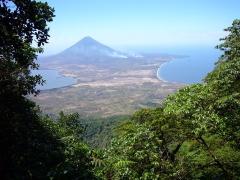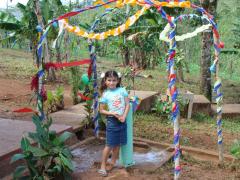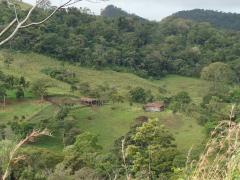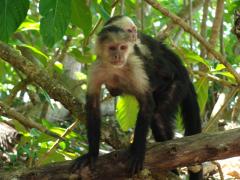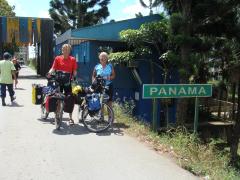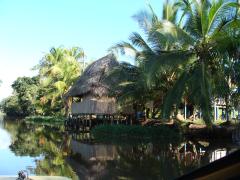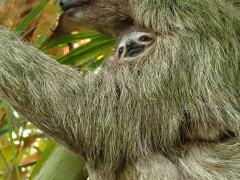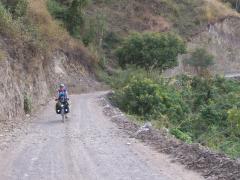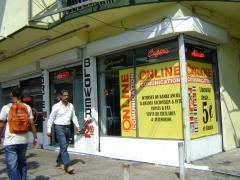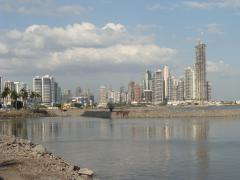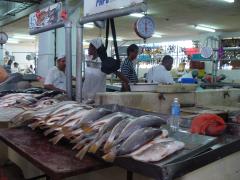Inuvik to Ushuaia
The Island of Ometepe, our last hurrah in Nicaragua
After riding back south from Rio Blanco in Nicaragua we spent one night at the tourist town of Granada, the port town at the north of Nicaragua. It's all full of tourists from all over the world, an easy gringo destination with a nice climate and beach and lake and great gringo services. Made us a little crazy though. In the morning we got on the 3-times-per-week ferry out to the island of Ometepe, in the middle of the lake. It took four hours and we got in after dark, but the next morning we found a beautiful island with a pair of dramatic volcanoes. We spent 3 days exploring and waiting for the ferry that would take us all the way to the bottom of the lake where we crossed into Costa Rica. If you ever want an easy place to get away from it all and spend a week or so with a really easy lifestyle, Ometepe is the place. So laid back and beautiful. Cheap. Good tourist services. Lots of hikes and things, and you're in the middle of a huge lake so there's lots of beaches and beachfront hotels. A very nice place.
APLV: Visits to actual communities getting water projects
We visited three impressive communities getting drinkable water in the Rio Blanco area. One was just in the preparation and funding stages, one was partly done, and the third was complete and beautiful, with a very remote community having clean, healthy drinking water 24 hours per day. I'll start with the one that was finished and work back to the one that was just about to get started.
Okawas
We had the delight of visiting the community of Okawás for the official ribbon cutting and handover ceremony for the new system. We got in a truck at 5;30 in the morning and drove for a couple of hours to a river crossing beyond which there was no road, crossed the river in a long motorized canoe, and then got on mules for the hour-long ride to the village. The trail started out pretty easy, but turned into some pretty impressive muddy and rocky ups and downs. With our little experience with horses we were a little nervous about how they were going to navigate the difficult terrain, but they did better than we would have. read more here... lee mas aquí... »
Nicaragua Tidbits
We found Nicaragua to be a delightful country. Despite the fact that all any of us remember about it is the war in the 80s and the US involvement in it, Nicaragua is a tranquil, safe, and friendly place. We didn't have to pretend that we weren't Americans... We were received with great friendliness everywhere we went. We found no vestiges of the 1980's socialist agenda, and museums were the only obvious physical relics of the wars.
We had heard various things about safety in Nicaragua, but what we found was a country where nobody seems worried about crime at all (except in Managua, which we didn't visit). Nicaragua is reputedly the safest country in Central America, possi bly including Costa Rica in that tally. Sometimes in Guatemala and Honduras when we would ask about a particular back road we would be warned off: "not enough people there, not enough police, dangerous", in Nicaragua we'd ask and they'd say "oh, yeah, that's great, no problems with delinquency here".
All this and Nicaragua is the most resource-poor country in Latin America, with a per-capita average income for the whole country of just $700 or so. We saw some pretty simple shacks, and there are far more outhouses in rural Nicaragua than there are flush toilets. There may not be any flush toilets in rural Nicaragua. read more here... lee mas aquí... »
Costa Rica: Just a quick visit
One of the delights of bike touring is that you spend most of your time in between big important tourism centers, instead of just going from one gringo hotspot to another. We get to meet ordinary people who are fascinated with us and have lots of questions and freely share their time and enthusiasm with us. And they are ordinary people who have not gotten jaded or tired of gringos or tourists. This is how the vast majority of our time in Mexico and Central America has been.
Then comes the famous tourist mecca of Costa Rica. Even though we've been here before, we didn't realize that the entire country has transformed itself into one huge vacation resort, almost an eco-Disneyland. We hardly passed a mile-long stretch in the whole country that didn't have tourist facilities and a sign in English. And we weren't in the main tourist part of the country! We probably didn't stay anyplace where there wasn't somebody that spoke English. Costa Rica is doing a fantastic job catering to tourists from all over the world, including all over Europe, the US and Canada, the Far East, and even places like Argentina. And there are no armed guards at the banks, which is a good sign. And it seems every town has a beautiful bakery where you can get fresh baked goods early in the morning. read more here... lee mas aquí... »
Into Panama - We're already in Panama City
We got to Panama from Costa Rica about ten days ago and have been working our way the (fairly long) length of the country.
We crossed an old railroad bridge to get across the border from Costa Rica on the little-used border crossing on the Caribbean - once again, no problems and no hassles, although we had to wait an hour or so for the single Panamanian clerk to get back from lunch or something.
From the border we rode another couple of hours to get to the pier for the water taxi to the main island of Bocas del Toro, a fantastic touristy area with lots of snorkelling and completely overrun with tourists. We had a very pleasant day snorkeling, seeing the brightest and most beautiful coral we've ever seen. Then we got back on a water taxi, went to the mainland, and started the ride through Panama.
In northern Panama we saw some amazing living situations - lots of shacks on the water, or in other areas on stilts. We rode through indigenous areas with people in more traditional clothes.
The second day out, we had the honor of doing our biggest one-day climb of the entire trip, over 6000 feet (almost 2000 meters). We crossed over the Continental Divide, hitting a maximum elevation of 4200 feet, and then descending the whole thing. The Caribbean side was mostly virgin rainforest, with waterfalls. read more here... lee mas aquí... »
(Our monthly email) Trip Update
We arrived in Panama City about 10 days ago and are taking a break now before going on to South America. Nancy flew to California for three weeks to help out her dad, who has been ill. He's much better now, but her help at home is much appreciated. She'll be back in early April and we're planning to take a boat to Cartagena, Colombia to begin the South American chapter of our trip. (What, you say? "I thought you weren't going to Colombia?" Well, what we hear from everybody we've met and even from the US State Department is that Colombia has improved markedly in the last few years and is an absolutely wonderful place to visit. So we'll keep our eyes and ears open and go that way.)
We have pictures for you: Costa Rica and Panama pictures and Nicaragua Pictures
And the map of our Central America route is complete so you can see exactly where we went.
Immigration Paperwork
Well, today I had my first taste of official paperwork and such. To date, passing all those borders, we haven't had any issues or problems at all. None of those horror stories you hear about crossing borders in Central America. No bribes, no corruption, no paperwork. We had to wait an hour for the border official to come back from lunch in Panama. Not too bad.
But in Panama they (seem to) only give you 30 days in the country. It's marked very clearly on our paperwork. So since I'll be here a tad more than 30 days (with Nancy home helping her dad) I went down to the immigration office today to do the deed. I figured it would take a little time.
First I waited in a long line to get a number and they took my passport number and told me I had to go across the street and get copies of my passport, the entry stamp, and the tourist card, along with 2 photos of myself.
I went and got the copies and the pictures from the very busy little stand across the street.
Then I went back and looked at the "next serving" sign, seeing that it would be a couple of hours at least before mine came up. So I started asking around what I needed to do. They told me that I couldn't apply for the extension until I did the registration, and that I'd have to get and fill out forms for both registration and the extension. So I went and stood in the line for the copier, which is where you get the forms.
Then I went back across the street to buy a pen, and filled out the forms.
Then I went back in and started asking everybody who looked competent what I should do. read more here... lee mas aquí... »
Nancy's tips on riding the roads of Latin America
I wrote this in response to a letter of consternation from one of the few other women (and one of the very few other "mature" couples) riding a route like ours in Latin America. It seemed worth while sharing with you, my management technics on how I managed riding the roads of Latin America.
This intrepid rider sent a note saying that the roads of Mexico were freaking her out so she was hopping on buses to avoid certain stretches and was having a difference of opinion about the risk level of the roads with her husband. Here is my response, such as it is:
First of all, I do think you have great amount of courage and smarts and capabilities. I admire you on many accounts. Anyone that has ridden Copper Canyon the way you you did has my admiration. If I knew you better, I might be more comfortable telling you that you have balls.
In retrospect, after riding through Mexico, Guatemala, Honduras, Nicaragua, and Panama, my thoughts about riding in Mexico are that it is a difficult country to ride in, especially as you get closer to the cities. The bigger the city, the more aggressive the drivers, and less room for mistakes.
What I've been up to: Working for Agua para la Vida
Well, Nancy will fly back tomorrow from California (where her dad is quite healthy, gracias a Diós, and we'll get on a boat to Colombia.
What have I been doing for these three weeks? In some ways, nothing. Every morning I get up at the rather boring (and too expensive at $22/night) hotel where I've been staying, walk to a little Chinese restaurant where I have coffee and read the newspaper, and then I go sit down at the internet cafe for the entire day working on the new website of Agua para la Vida, the wonderful organization we visited in Nicaragua that builds rural drinking water systems. It has been a strange little interlude in a fairly uninteresting place, lonely of course without Nancy here (both as a friend and as our primary friend-maker!)
Anyway, Agua para la Vida now has a new Drupal-based website, with database-oriented features that allow a map of the sites they have built, reporting capabilities for donations, and the like. I could have been volunteering for them in Nicaragua for these three weeks and it would have been more enjoyable and social in many ways, but on the other hand the technology would have been a real challenge. Here I have decent, cheap places to work (there's even a 24-hour internet cafe) and good speed and quality.
But I'll be really glad to see Nancy tomorrow and continue on our way!
Panama City
Panama City is certainly the most cosmopolitan place we've been in Central America, possibly in all of Latin America so far. Of course we've skipped a couple of the capital cities, like Guatemala City. But parts of the city are just full of skyscrapers and cranes, and there are gringos all over the place, and slick brochures about all the fancy condos you can buy in those high-rises. It really looks like Miami, and when you think about it, Panama City is probably giving Miami a run for its money. Miami used to be the big central point for rich Latin Americans to visit, with good shopping and comfort and luxury. But Panama City is so much more central, and has everything including the shopping, and is probably safer.... I'd say you should probably invest in Panama if you're the investing type.
Panama in general and Panama City specifically are also far more diverse than any place we've yet been in Latin America - approaching Panama City we saw several mosques. In my hotel there have been a number of traditional rabbis. And there is a vast array of skin colors, from Caribbean blacks to blonde gringos. And the Chinese seem to have the mini-super business sewed up throughout the country, and the cheap restaurant business in part of it.
But of course the rich fancy condos and diversity aren't the only story. This is a big city. There are beggars and some very poor people. You'll see the young men coming through on their rapid check of the street garbage containers checking for aluminum cans. But the sad thing is that there will be one guy coming right after another one... So there aren't enough cans to go around. read more here... lee mas aquí... »

